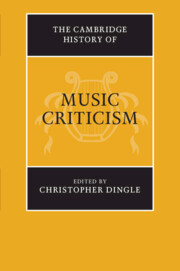Book contents
- The Cambridge History of Music Criticism
- The Cambridge History of Music
- The Cambridge History of Music Criticism
- Copyright page
- Contents
- Music Examples, Figures and Tables
- Notes on Contributors
- Acknowledgements
- Introduction
- Part I The Early History of Music Criticism
- 1 Speaking of Plainsong in the Middle Ages
- 2 Music Criticism in the Late-Medieval and Renaissance Era
- 3 Musical Discourse in Italy, 1500–1800
- 4 Music Criticism in France before the Revolution
- 5 Music Criticism in Britain up to Burney
- 6 German-Language Music Criticism before 1800
- Part II The Rise of the Press
- Part III Critical Influence and Influences
- Part IV Entering the Twentieth Century
- Part V New Areas
- Part VI Developments since the Second World War
- Postlude
- Bibliography
- Index
1 - Speaking of Plainsong in the Middle Ages
from Part I - The Early History of Music Criticism
Published online by Cambridge University Press: 21 August 2019
- The Cambridge History of Music Criticism
- The Cambridge History of Music
- The Cambridge History of Music Criticism
- Copyright page
- Contents
- Music Examples, Figures and Tables
- Notes on Contributors
- Acknowledgements
- Introduction
- Part I The Early History of Music Criticism
- 1 Speaking of Plainsong in the Middle Ages
- 2 Music Criticism in the Late-Medieval and Renaissance Era
- 3 Musical Discourse in Italy, 1500–1800
- 4 Music Criticism in France before the Revolution
- 5 Music Criticism in Britain up to Burney
- 6 German-Language Music Criticism before 1800
- Part II The Rise of the Press
- Part III Critical Influence and Influences
- Part IV Entering the Twentieth Century
- Part V New Areas
- Part VI Developments since the Second World War
- Postlude
- Bibliography
- Index
Summary
Apparently the Middle Ages did not produce much music criticism. It could scarcely be otherwise if, as has been claimed, criticism as an institution, meaning ‘a specific discursive medium characterized by the controlled exercise of authority and judgment’ has ‘a history reaching back to the eighteenth century’ and seemingly no further. Consider the substantial repertoire of Gregorian chant, once employed throughout much of the Latin West, and the plainsong that is principally evoked in the title of this chapter. The monks, friars, nuns and clerics who sang this music in the liturgy were not required to perform in any sense of the word recognisable from many later periods of musical history, even when they were cantors assigned solo chants. Those standing near them in the choirstalls heard them sing, but we may suppose that they did not exactly listen for much of the time; plainsong was not designed to promote concentration upon an art of autonomous musical sound. Even if the music of a particular chant drew the ear of someone present, it was surely difficult to bring a varied discernment to bear upon material for which a pope, inspired by the Holy Spirit, was believed to be responsible.
- Type
- Chapter
- Information
- The Cambridge History of Music Criticism , pp. 9 - 24Publisher: Cambridge University PressPrint publication year: 2019

